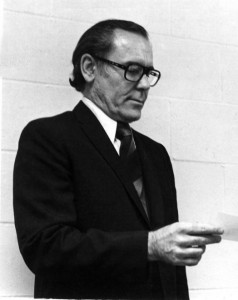









Gallery |
Starting from ScratchSeptember 13, 2012 By Kelly Dyer Today, at the venerable age of 90, Professor Emeritus Dr. Bob Fonda cheerfully admits that he has seen many milestones over the years at Minnesota State Mankato. One of those would most certainly be celebrating the 40th anniversary of the Dental Hygiene Program, which Fonda started almost single-handedly in 1969.  Dr. Robert Fonda will be at the Department of Dental Hygiene’s 40th Anniversary Reunion on Saturday, September 29 in the Centennial Student Union Ballroom. Although the program has turned out countless well-qualified dental hygiene graduates over the past four decades, it got off to what Fonda characterizes as something of a “rough start.” That may be a bit of an understatement. The genesis of the program came about like this: After spending four years in the Navy, Fonda practiced dentistry for 23 years in the small town of Rockwell City, Iowa. Unfortunately, spending that many years hunching over patients as he worked contributed to significant back problems, and in 1969, Fonda began to think about finding a new job in the dental field. At about that same time, Minnesota State Mankato was investigating the possibility of starting a professional two-year dental hygiene program. Fonda met with college administrators and was offered a job. He accepted and agreed to come to campus to start putting the program together late in 1969. What Fonda discovered once he arrived on campus was nothing. No books had been ordered. He didn’t have a classroom, a secretary or even a telephone. The college lacked a physical clinic in which students could receive practical instruction, and in fact, there wasn’t even a curriculum outline for the classes that were scheduled to begin the following spring. Asked now if he realized what he was getting himself into all those years ago, Fonda chuckles. “No, not really,” he says. “I thought I knew but as in many cases, after you get there and sign the contracts and so on, you discover that there are other things that you are going to have to do…that weren’t maybe exactly the way you want to have them, but you just take the ball and run.”  The history of the Dental Hygiene Program — and Dr. Fonda’s role in it — is documented in a new book from the department. Fonda rolled up his sleeves and got to work. The first order of business was to design a program and curriculum that would meet the accreditation standards of the American Dental Association. He spent countless hours doing that. He also began to interview and hire professional staff who could then teach to those standards. That done, Fonda turned his attention to another pressing problem: The University had purchased a significant amount of used dental equipment from the Veteran’s Administration in anticipation of the new program. As Fonda inspected that equipment, however, he discovered that much of it was hopelessly outdated, damaged or simply not acceptable for use in modern dentistry. That started another scramble to find better equipment. In addition, the physical clinic needed to be constructed, and Fonda spent a great deal of time supervising the construction, all while also sorting out the other details that the new classes would entail. “I had some sleepless nights, let’s put it that way,” he says. “Sometimes I went home at night and just laid there and looked at the ceiling and thought, “Oh my goodness…” Classes began in 1970 on the lower campus, with Fonda and the other instructors traveling from classroom to classroom carrying their tools and textbooks with them. In spite of all of the confusion of those early days, Fonda says he loved teaching. “I liked passing on the information that needed to be passed on to students about dentistry and the various aspects of dentistry, and what kind of background would be required so that you would even be able to perform the duties,” he says. “I loved the student contact. I just thoroughly enjoyed that.” As the program attracted more students, Fonda was also instrumental in finding new ways for the students to interact with the public at large, including working at the Faribault State Hospital, nursing homes, the White Earth Indian Reservation and other areas. Today, Fonda remains delighted with the progress of the program he fathered. Even though he retired in 1986, he remains fiercely proud of its success. “It was a pleasure for me,” he says. “I wouldn’t have missed it for anything.” Leave a ReplyYou must be logged in to post a comment. |